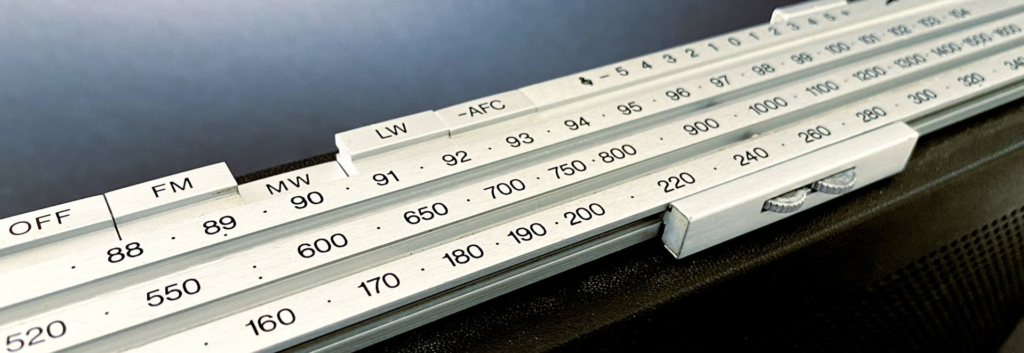Welcome to MW DX

What is MW DX?
“Let’s start at the very beginning, a very good place to start…” Julie Andrews sang Rodgers and Hammerstein’s famous line in The Sound of Music. And that’s good advice.
MW refers to the Medium Wave band found on most radios ever manufactured and it is the band that has been used for radio broadcasting ever since the birth of radio over 100 years ago. In some countries the MW band is often labeled as the AM band, or OM (ondes moyennes or onda media, onde medie) or MG (middengolf); they all mean the same thing.
DX is an expression referring to distance. It is an abbreviation that arose in the early days of radio when it was quicker and easier to send “DX” in Morse code than the full length word.
So, unsurprisingly “MW DX” refers to the hobby of listening to distant medium wave radio stations and finding that the radio dial can bring the world to you.
How do I MW DX?
It is amazingly simple to hear distant medium wave radio stations and you don’t need expensive equipment to get started. Have you ever listened to the MW band at night and wondered why you can hear many more stations than during the day? Have you noticed stations in far off countries or provinces? Here in the UK the best clue is the presence of programmes not in English – you don’t need to be a linguist to pick out Spanish, and Italian. If you’ve enjoyed a Mediterranean holiday you’ll recognise these. You’ll also probably hear Russian and Romanian and Arabic from more distant countries.
All you need to do this is a car radio with an AM or MW band. Take your car to a rural location at night away from buildings and power lines, kill the engine and then spin the dial for an hour or so. If you use a radio made this century it will accurately display the frequency (in kHz) that you are tuned to.
If you make a note of the time and frequency and what you heard then you’ve started MW DXing. It’s that simple. One of the exciting aspects of DXing is that the next time you tune into the same frequency there is good chance you’ll hear a different station, perhaps in a different country. That’s especially true if you try listening at different times.
During the day you might hear a small number of stations, mostly located within 100km of you. At sunset you will start to receive signals arriving from stations mainly to the East of you. This is because the world to the East is already in darkness.
Overnight you should be able hear stations in most directions, but you might realise that some stations disappear at a particular time. That’s because they are not broadcasting 24 hours a day. When a powerful station shuts down and the staff go home, that gives you the opportunity to hear something rare and more unusual on the same frequency.
By dawn, the earth has turned on its axis and daylight is approaching from the East. But you will find that you can still hear faraway stations from the West. For example here in the UK, dawn is often a great time to hear stations in the USA or Canada. That is helped by the fact that closer and therefore stronger signals in Europe are starting to become weaker signals as they experience daylight. Yes, I did say USA & Canada!
So armed with a notebook and a car radio or a portable radio (both preferably with digital frequency readout) you can get started. You’ll quickly hear dozens of stations and before long you’ll have heard 100 or more. And in Europe you’ll quickly hear countries as exotic as Algeria, Russia and Egypt. But once the bug bites, that is just the beginning.
With experience you’ll start to notice and perhaps identify stations many thousands of km away from your listening post. Depending on where you are you’ll eventually hear stations from several continents. You may even hear something so unusual that no one else has heard it before!
Where does it go from here?
Many enthusiastic MW DXers try to hear as many exotic stations as possible in as many countries as possible. To this end they quickly upgrade their radio, often building a sophisticated listening post, augmented by advanced antenna (aerials) designed to pull even the weakest signals out of the aether.
Others specialise in the linguistics often needed to identify a weak and noisy signal talking in an obscure foreign language. And yet other DXers focus on trying to achieve the most using “simple” budget receivers – with amazing results for an investment of £50 ($70) or so. You’ll discover that the hobby of MW DXing has many interesting facets.
In order to make best use of hobby time MW DXers rely on data and information about stations, their locations and schedules as well as reports from other enthusiasts as to what is being heard where, when and why. So though you may be sitting alone at a receiver, you are not when you connect with the worldwide community of MW DX listeners.
So this is where a club like the Medium Wave Circle comes in. For over 65 years we have been a community of MW DXers sharing knowledge, ideas and enthusiasm. Today we have members in over 25 countries. Some are engineers, some are broadcasters, others are linguists, some enjoy faraway music or sport, but all are fascinated with long distance MW radio listening and the mysteries that the radio dial can bring.